
Note:(i) All questions are compulsory. The marks allotted for each question areindicatedagainsteach question.
(ii) Write your name, enrollment number, AI name, and subject on the top of the first page of the answer sheet
1.Answer any one of the following questions in about 40-60 words
a)What is the medium of the sculpture "Priest Bust"? Write about it in brief.
Answer- The captivating "Priest Bust" from Mohenjo-daro is sculpted from steatite, a soft mineral often called soapstone. This allowed for precise carving of the dignified face and intricate details like the headband and cloak. Despite being unfinished, the sculpture's fiery hardness adds to its mystique, showcasing the Indus Valley civilization's artistic skill in working with diverse materials.
b)"Chand Bibi Hawking" was painted during which period? Which school of painting does it belong to?
Answer-"Chand Bibi Hawking" paintings, depicting the legendary Queen of Ahmadnagar, fall within the 17th-18th century period. They belong to the Deccani School of painting, which flourished in the Deccan Plateau of India during that era.
2. Answer any one of the following questions in about 40-60 words.
a) Write any two features of Indus Valley sculptures.
Answer- Emphasis on Religious Figures:
Indus Valley art heavily featured portrayals of deities and spiritual figures.
The iconic Mother Goddess figurines, found in terracotta and steatite, are widely recognized. These figures typically stand or sit, adorned with elaborate headdresses and jewelry, symbolizing fertility and prosperity.
b) "The halo is a significant contribution to the Gandhara school." Justify the statement.
Answer-1. Innovation: Prior to the Gandhara school, Buddha figures were depicted symbolically, often aniconic (without physical form). The Gandhara school's adoption of the halo, likely borrowed from Greco-Roman artistic traditions, provided a visual cue for divinity and spiritual enlightenment, setting Buddha apart from other figures.
3. any one of the following questions in about 40-60 words.
a) Write any two differences between Akbari Period painting and Jahangir period painting with one example each.
Answer-(i) Subject matter: Akbari paintings embraced grand historical narratives and epic scenes, often depicting battles or court assemblies. Jahangir favoured intimate portraits, nature studies, and scenes from his personal life, reflecting his introspective nature. Example: Akbari - "Akbar Nama" depicting battlefield panorama; Jahangir - "Portrait of Jahangir with a Falcon," showcasing detailed natural observation.
(ii) Color palette: Akbari works used bold, vibrant colors, mirroring the dynamism of his reign. Jahangir preferred softer, more delicate hues, reflecting his refined aesthetic and love for nature's subtlety. Example: Akbari - "Jahangir Receiving English Ambassador William Hawkins" with rich reds and blues; Jahangir - "A Night Heron in a Lotus Pond" with muted greens and browns.
b) Write a brief note "Ganjifa", cite one example.
Answer-Ganjifa is a type of playing card that was brought to India from Persia by the Mughals in the 16th century. Ganjifa cards are square, circular or oval and contain images of animals, birds, gods, mythological creatures, etc. Ganjifa cards are 8, 10 or 12 in number.
Example: In Odisha, Ganjifa cards depict scenes from Ramayana, Mahabharata, Krishna Leela etc.
Ginnifer is a rich cultural heritage that forms an important part of the art and culture of India.
4. Answer any one of the following questions in about 100-150 words.
a)Describe Mauryan and post Mauryan sculptures similarities or differences with any examples.
Answer-Emphasis on narrative: Both periods used sculptures to tell stories, often religious or historical. For example, Mauryan pillars depict Emperor Ashoka's edicts, while post-Mauryan reliefs at Sanchi Stupa illustrate the life of the Buddha.
(i) Symbolic animals: Both use animals as symbols. Mauryan capitals feature lions, elephants, and bulls representing power and royalty, while post-Mauryan sculptures often depict mythical creatures like garudas and makara.
Differences:
(i) Emphasis on narrative: Both periods used sculptures to tell stories, often religious or historical. For example, Mauryan pillars depict Emperor Ashoka's edicts, while post-Mauryan reliefs at Sanchi Stupa illustrate the life of the Buddha.
(ii) Symbolic animals: Both use animals as symbols. Mauryan capitals feature lions, elephants, and bulls representing power and royalty, while post-Mauryan sculptures often depict mythical creatures like garudas and makara.
(b) Write about the sculptural features of Indus Valley Civilization with any two examples.
Answer-The Indus Valley Civilization sculpted in stone, metal, and terracotta, leaving behind a captivating glimpse of their world. These works, often small and intricate, showcased remarkable craftsmanship and attention to detail.
(i) Take the bronze "Dancing Girl" from Mohenjo-daro. This iconic figure, adorned with elaborate jewellery and a vibrant posture, exudes both dynamism and delicate beauty. In contrast, the "Priest-King" bust, carved from steatite, presents a solemn figure with piercing eyes and a distinctive turban. Its use of composite materials reveals advanced sculptural techniques.
(ii) These two examples, despite their contrasting subjects, highlight the Indus Valley's artistic range. Their realism, attention to detail, and varied materials offer a window into a sophisticated and vibrant civilization.
5. Answer any one of the following questions in about 100-150 words.
a)Write a note on "Tanjore Painting collecting information from available library resources.
Answer-Tanjore painting is a classical South Indian painting style that originated from Thanjavur. The source of inspiration for this art is the arts of the heroes of 1600 AD. Tanjore paintings were the first to be used to show Hindu gods and goddesses in their full glory. The figures in these paintings are usually gigantic with round, divine faces.
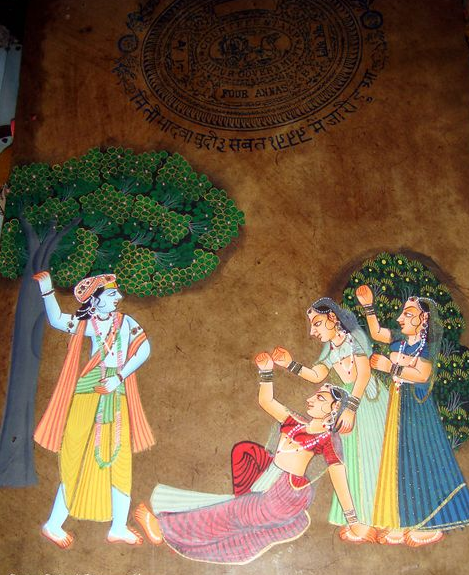
Following are the main features of Tanjore painting:
(i) Theme: The main theme of Tanjore paintings is Hinduism. These depict Hindu gods and goddesses, religious stories, and mythological scenes.
(ii) Technique: A special type of wooden plank is used to make Tanjore paintings. This board is painted yellow, and then drawings are made on it with white colour. Gold foil is also used in the paintings, which gives them a special shine.
(iii) Style: The style of Tanjore paintings is very beautiful and artistic. The figures in these paintings are depicted very minutely, and the colours are used very aesthetically.
b) Write any four features of Mughal Painting.
Answer-(a) A fusion of styles: Mughal paintings are a unique blend of Persian, Indian, and European influences. This is evident in the use of vibrant colours and gold from Persian miniatures, the detailed brushwork and naturalism from Indian art, and the perspective techniques from European Renaissance painting.
(b) Rich and vivid colours: One of the most striking features of Mughal paintings is their use of rich and vibrant colours. Lapis lazuli blue, emerald green, and gold are commonly used, creating a sense of opulence and grandeur. \
(c) Meticulous detail: Mughal paintings are incredibly detailed, with fine brushwork and intricate patterns. This is especially evident in the depiction of clothing, jewellery, and landscapes.
(d) Diverse subject matter: Mughal paintings depict a wide range of subjects, including portraits of emperors and courtiers, scenes from court life, battles, hunting expeditions, and religious stories
6. Prepare any one project of the following projects given below.
a) Using any two dry mediums make a composition of your choice? Take a photograph and paste it on your drawing sheet.
Answer-Theme:
(i) Contrast: Play with opposites using your two dry mediums. For example, create a stark black and white scene using charcoal and white conte crayons.
(ii) Texture: Combine the rough, gritty texture of charcoal with the smooth, delicate lines of graphite to create a landscape with both rugged mountains and soft clouds.
(iii) Surrealism: Use found objects and collage elements along with your dry mediums to create a dreamlike scene.
Mediums:
(i) Charcoal and coloured pencils: Draw a portrait with realistic charcoal shading and vibrant coloured pencil accents for the eyes and lips.
(ii) Pastel and graphite: Sketch a cityscape with buildings in detailed graphite lines and the sky filled with swirling pastel clouds.
(iii) Sandpaper and conte crayons: Create a minimalist seascape by scratching through black conte crayon on sandpaper to reveal the white texture underneath for waves and foam.
b) Using Oil pastels make composition either geometric or figurative (Human or animal) on your drawing sheet.
Answer-Abstract cityscapes: Build a vibrant cityscape using stacked rectangles, triangles, and trapezoids in bold oil pastel colours. Play with contrasting values and textures to create depth and dimension.
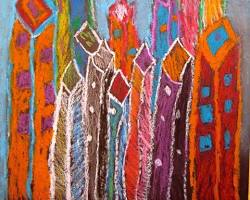
Tessellations: Create a mesmerising tessellation pattern using repeating geometric shapes like squares, hexagons, or even triangles filled with vibrant gradients or contrasting colours.
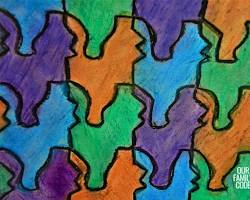
Fractals: Explore the infinite beauty of fractals by drawing branching patterns and repeating shapes in an ever-decreasing scale. Use a limited color palette for a sophisticated look.
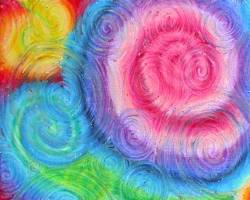
Figurative:
Close-up portraits: Focus on a specific feature like eyes, lips, or hands and exaggerate the details for a dramatic effect. Play with blending and layering to create realistic textures and skin tones.
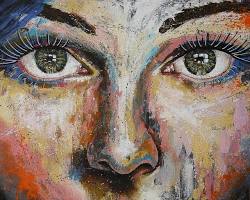
Closeup portraits with oil pastels
Animal silhouettes: Capture the graceful form of an animal in a minimalist silhouette against a vibrant background. Use a single color for the animal and experiment with blending gradients for the background.
Indus Valley art heavily featured portrayals of deities and spiritual figures.
The iconic Mother Goddess figurines, found in terracotta and steatite, are widely recognized. These figures typically stand or sit, adorned with elaborate headdresses and jewelry, symbolizing fertility and prosperity.
